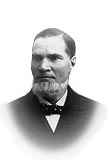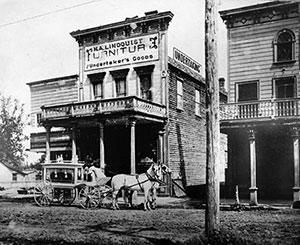Niels A. Lindquist ~ Index

Upon arriving in Salt Lake City in 1863, Swedish immigrant and Mormon convert, Nils (Niels) A. Lindquist, established himself as a premiere furniture maker. One of his beautiful beds is still exhibited today in Brigham Young's Beehive House, in Salt Lake City.
In 1867, Nils fulfilled a calling from, Brigham Young to help settle the Logan area and become a cabinet and furniture maker for a growing Cache Valley. Soon thereafter, he began making caskets and became the town undertaker, naming his enterprise N.A. Lindquist Furniture and Undertaking Goods. The shop's location was "One Door East of Tithing Office, Logan."
Nils's oldest son, Charles J.A., learned the family trade starting with his father and following the first of two L.D.S. missions to Sweden, moved his family to Ogden establishing a mortuary in 1885. As his sons Carl, Clyde and Milton entered the family business the name evolved to C.J.A. Lindquist & Sons Mortuary. Upon C.J.A.'s death in 1934, his sons, along with his second wife, Ada, continued their service to the families of northern Utah. Their son, John A. Lindquist, began working at the mortuary at an early age. He obtained his education at Weber College and served with distinction in the Army Air Corps in WW II.

Furniture Maker to Undertaker
Neils Lindquist was an accomplished cabinetmaker who converted to Mormonism and emigrated from Sweden to Salt Lake City in 1863. He built furniture in Salt Lake, and a bed he built is in the Beehive House today. Called by Brigham Young to help settle the Logan area in 1868, Lindquist set up a furniture shop that became the leading business of its kind in Cache Valley. It was difficult to get hardwoods in Utah, so most of the furniture in the territory was built of cedar, pine and aspen, which affected design and use. Furniture legs made of soft woods had to be thicker than those of hardwoods to support the same weight, so Utah furniture had an awkward appearance. Lindquist's furniture, however, though made of softwoods, was characterized by graceful lines. With the coming of the railroad to Cache Valley in 1873, it suddenly became possible to import hardwood furniture from the east at a reasonable cost. In spite of Mormon leaders' encouragement that members should only buy locally made goods, the rush to the more fashionable hardwoods was on.
Like most furniture makers and carpenters, Lindquist made coffins as part of his business. When the railroad came, he began selling imported furniture as well as his own, and the coffin business remained steady, so Lindquist changed the name of his business to N.A. Lindquist Furniture and Undertaking Goods. Eventually, the trend away from home manufactured furniture in favor of imported pieces took its toll. When the business passed to Lindquist's son, Charles, he moved to Ogden and in 1885 turned the business entirely to coffin making and undertaking, founding the Lindquist Mortuaries, which still operate in Weber and Davis Counties today.
Consumers' preference for imported furniture eventually put all local cabinetmakers out of business. Some switched to general carpentry and building, and some, like the Lindquists, found another profession that, at first blush may seem unrelated, but which was a logical transition for a cabinetmaker of the late nineteenth century.
Notes…
A Presbyterian school of six pupils was started in Logan in September of 1878 by Rev. Calvin M. Parks and his wife. The schoolroom and chapel was under a furniture manufactory in the Lindquist Building on First North Street. By 1878 some five years after the railroad had reached Cache Valley, the need for localy made funiture had decreased to where the main floor of the Lindquist building was not needed at the time.